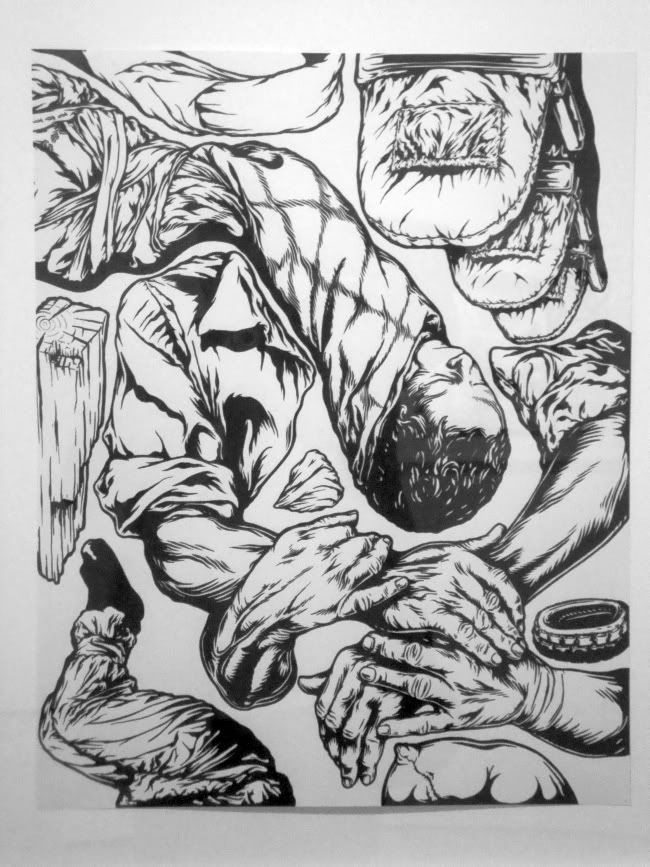I missed the opening for this show somehow, but I'm glad I was able to catch up. I like Beasley's new thing, these disturbing fragmented drawings. I have liked them ever since a won a very small one in the silent auction at the Retablo show last year at Lawndale. So I am not an unbiased observer of this work.

Kenneth James Beasley, Hymnal-Suitcase-Spat, pigmented acrylic ink on paper, 2010. (Photo by Robert Boyd.)
Kenneth James Beasley calls these works "accumulations" that are composed of "collage components." That's accurate as far as it goes. (It also would be a reasonable description of his quite different earlier work.) The drawn pieces typically feature several elements which are fragments of a human body (although occasionally complete figures appear). The fragments are related to the titles, which consist of a series of seemingly unrelated words like Hymnal-Suitcase-Spat. In this case, the style of the suitcase, the presence of spats (particularly the military-looking spats drawn hear) and the hymnal give this an old fashioned feel. Not nostalgic, though. The fragments are too weird to be nostalgic, and the presence of the hand grabbing the leg implies a certain strange menace.

Kenneth James Beasley, Dummy-Pickaxe-Wreck, pigmented acrylic ink on paper, 2010. (Photo by Robert Boyd.)
This feeling of menace pervades Beasley's drawn work. I hate to use such a cliched term, but the work is quite noirish. It feels like fragments of forgotten Jim Thompson novels, or like such movies as Out of the Past or Night of the Hunter.

Kenneth James Beasley, Dead-Carry-Yell, pigmented acrylic ink on paper, 2010. (Photo by Robert Boyd.)
The drawing accentuates this. In fact, it strongly reminds me of the drawing style of contemporary cartoonist Tim Lane, who is mining some of the same territory. Like Lane, Beasley is presenting ambiguous works. The fragments don't cohere into an obvious narrative. I have always thought the weakness of the detective fiction genre is the need for a resolution--for the case to be solved. Every reader of crime fiction knows that the best parts are the mystery, the feeling of unresolved menace. That is the feeling you get in Beasley's work.

Kenneth James Beasley, Chairs-Embrace, pigmented acrylic ink on paper, 2010. (Photo by Robert Boyd.)
He varies each composition with the number of elements, the size and relative scale of the elements, and the amount of white space. These may be signals about which elements are most important. Beyond the formal composition, I can see two metaphorical ways of looking at these fragments. First, imagine you are a police detective or a sheriff who has a grisly, disturbing crime to solve. These fragments could represent the only information you have, and out of such fragmentary information, you must construct a narrative. You must impose logic and reason onto this chaos and violence. And you wonder if you can.

Kenneth James Beasley, Calf-Scream-Mattress, pigmented acrylic ink on paper, 2010. (Photo by Robert Boyd.)
Or, imagine that you were part of this. What part, you don't know--victim? Bystander? Murderer? But trauma--physical or mental--is preventing you from remembering it. All you have are fragments, which torment you in their suggestiveness without telling you your part.
I have no idea if Beasley thought of any of these things while drawing them. Did Beasley have a narrative in mind for each accumulation? Or are they the result of some random choice, some oblique strategy? I'd be curious to know, but I don't think it matters in the end. Viewers will attempt to make sense of these disquieting images any way they can.
Tweet





No comments:
Post a Comment